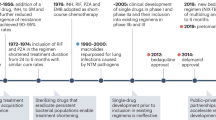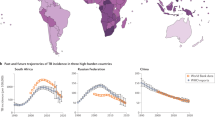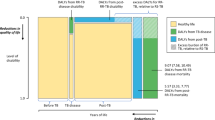Abstract
Which papers have provided the most interesting recent advances in tuberculosis research? Which new discoveries in pathogenesis, epidemiology, drug discovery or vaccine development have been the most important or are likely to have the highest impact to the field?
Similar content being viewed by others
Main

Rather than relying on citations, we posed these questions directly to the tuberculosis community and asked TB researchers to identify what they perceived as the most important papers over the past 3 years. We received feedback from around 50 experts. Their responses were astonishingly diverse, no doubt reflecting the diverse expertise of the scientists we polled. The hot list—papers suggested by at least three experts—along with some illuminating comments, is presented below. The numbers in blue show the percentage of respondents who picked that paper.
Topping the list is the identification of a new drug for tuberculosis that works by inhibiting a completely new target. Such new drugs are sorely needed, and nothing highlights this more strongly than the paper that appears at number two in the hot list. The Lancet report by Gerald Friedland and colleagues describes the extremely high mortality rates seen in HIV-infected patients infected with extensively drug-resistant TB (XDR-TB)—a strain resistant to almost all currently available drugs.
Perusing the other papers, five themes emerged as having seen important advances: secretion of virulence factors, new tools in genomics, new drugs, bacterial survival and metabolism. The papers from the top twenty that advanced these areas (shaded in yellow) are placed in context by experts in the field in the News and Views articles on pages 279–287. The remaining papers from the list (shaded in blue) are discussed in brief on pages 288–289. And to find out how much resemblance this top twenty bears to a list of high-impact papers generated by more traditional means (citations), turn to page 278.
40%
Andries, K. et al. A diarylquinoline drug active on the ATP synthase of Mycobacterium tuberculosis. Science 307, 223–227 (2005).
“One of the most promising new anti-TB drugs currently in development.” Christopher Walsh, Harvard
24%
Ghandi, N.R. et al. Extensively drug-resistant tuberculosis as a cause of death in patients co-infected with tuberculosis and HIV in a rural area of South Africa. Lancet 368, 1575–1580 (2006).
“A jolt to reality. The XDR-TB patients all died and almost all died within 16 days of the sputum samples being collected. It gave a crisis perspective to a problem we all knew existed but were adopting an ostrich approach to.” Salim Abdool Karim, KwaZulu-Natal
22%
Grode, L. et al. Increased vaccine efficacy against tuberculosis of recombinant Mycobacterium bovis bacille Calmette-Guerin mutants that secrete listeriolysin. J. Clin. Invest. 115, 2472–2479 (2005).
“Previously the only type of TB vaccine more potent than BCG was BCG overexpressing a major TB antigen. This paper represents another type of altered BCG vaccine. Although it has not yet been reported to show superior efficacy in the more stringent guinea pig model, it is a promising new approach.” Marcus Horwitz, UCLA
20%
Champion, P.A., Stanley, S.A., Champion, M.M., Brown, E.J. & Cox, J.S. C-terminal signal sequence promotes virulence factor secretion in Mycobacterium tuberculosis. Science 313, 1632–1636 (2006).
Munoz-Elias, E.J. & McKinney, J.D. Mycobacterium tuberculosis isocitrate lyases 1 and 2 are jointly required for in vivo growth and virulence. Nat. Med. 11, 638–644 (2005).
“The first indication of the signal that promotes virulence factor secretion.” Paul Van Helden, Stellenbosch
11%
McShane, H. et al. Recombinant modified vaccinia virus Ankara expressing antigen 85A boosts BCG-primed and naturally acquired antimycobacterial immunity in humans. Nat. Med. 10, 1240–1244 (2004).
“The first clinical trial showing that a novel subunit TB vaccine could boost IFN- g responses in BCG-vaccinated humans, paving the way for further clinical trials.” Philip Marsh, Health Protection Agency, UK
8.9%
Cosma, C.L., Humbert, O. & Ramakrishnan, L. Superinfecting mycobacteria home to established tuberculous granulomas. Nat. Immunol. 5, 828–835 (2004).
Matsumoto, M. et al. OPC-67683, a nitro-dihydro-imidazooxazole derivative with promising action against tuberculosis in vitro and in mice. PLoS Med. 3, e466 (2006).
Reed, M.B et al. A glycolipid of hypervirulent tuberculosis strains that inhibits the innate immune response. Nature 431, 84–87 (2004).
“An important addition to the TB drug pipeline. We need several candidates such as this one to develop a totally new regimen that shortens the current treatment duration to 2–3 months.” Koen Andries, Johnson & Johnson
6.7%
Boshoff, H.I. et al. The transcriptional responses of Mycobacterium tuberculosis to inhibitors of metabolism: novel insights into drug mechanisms of action. J. Biol. Chem. 279, 40174–40184 (2004).
Burman, W.J. et al. Moxifloxacin versus ethambutol in the first 2 months of treatment for pulmonary tuberculosis. Am. J. Respir. Crit. Care Med. 174, 331–338 (2006).
“Moxifloxacin is the furthest along new drug for TB. Among other things this paper highlights the need for greatly increased clinical trials capacity for TB.” Neil Schluger, Columbia
Flores-Villanueva, P.O. et al A functional promoter polymorphism in monocyte chemoattractant protein-1 is associated with increased susceptibility to pulmonary tuberculosis. J. Exp. Med. 202, 1649–1658 (2005).
“The first study to identify in ethnically diverse human populations a common genetic variation that predisposes those infected with Mycobacterium tuberculosis to develop clinically evident disease.” Carl Nathan, Cornell
Gutierrez, M.C. et al. Ancient origin and gene mosaicism of the progenitor of Mycobacterium tuberculosis. PLoS Pathog. 1, e5 (2005).
Makinoshima, H. & Glickman, M.S. Regulation of Mycobacterium tuberculosis cell envelope composition and virulence by intramembrane proteolysis. Nature 436, 406–409 (2005).
Manjunatha et al. Identification of a nitroimidazo-oxazine-specific protein involved in PA-824 resistance in Mycobacterium tuberculosis. Proc. Natl. Acad. Sci. USA. 103, 431–436 (2006).
Rengarajan, J., Bloom, B.R. & Rubin, E.J. Genome-wide requirements for Mycobacterium tuberculosis adaptation and survival in macrophages. Proc. Natl. Acad. Sci. USA 102, 8327–8332 (2005).
Sassetti, C.M., Boyd, D.H. & Rubin, E.J. Genes required for mycobacterial growth defined by high density mutagenesis. Mol Microbiol. 48, 77–84 (2007).
Stanley, S.A., Raghavan, S., Hwang, W.W. & Cox, J.S. Acute infection and macrophage subversion by Mycobacterium tuberculosis require a specialized secretion system. Proc. Natl. Acad. Sci. USA 100, 13001–13006 (2003).
Voskuil, M.I. et al. Inhibition of respiration by nitric oxide induces a Mycobacterium tuberculosis dormancy program. J. Exp. Med. 198, 705–713 (2003).
“Another promising clinical candidate. The authors investigate mutants that are resistant to PA-824, teasing apart both the molecular basis of resistance and the mechanism of its intracellular activation, both of which will provide clues to help guide structure–activity relationships in this drug class.” Michael Fischbach, Harvard
“The greatest challenge in treating tuberculosis is that organisms persist for extended periods of time despite antibiotic therapy. This paper describes some of the physiologic responses that underlie one of the possible mechanisms of persistence—adaptation to low-oxygen environment.” Eric Rubin, Harvard
Walburger, A. et al. Protein kinase G from pathogenic mycobacteria promotes survival within macrophages. Science 304, 1800–1804 (2004).
Author information
Consortia
Rights and permissions
About this article
Cite this article
Nature Publishing Group. The top twenty papers on tuberculosis. Nat Med 13, 276–277 (2007). https://doi.org/10.1038/nm0307-276
Issue Date:
DOI: https://doi.org/10.1038/nm0307-276



